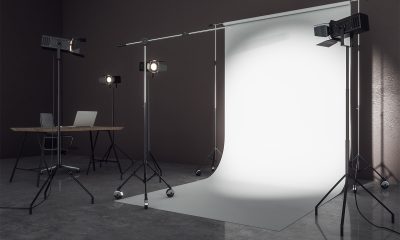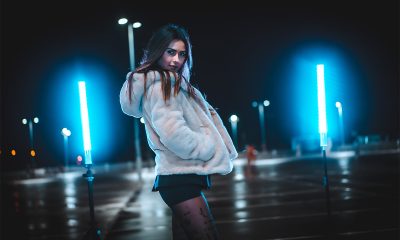What is an on-camera video light
An on-camera video light is a continuous lighting instrument that can be easily added to the shoe mount of a professional video camera. Videography and cinematography, as with photography, are the process, activity and art of capturing light and recording it on a sensitive medium, such as a photographic film, or an electronic sensor. When shooting inside a building or in a low ambient light outdoor environment, natural ambient light may be not sufficient or does not permit proper exposure. Artificial lighting thus comes into operation to improve the luminous environment. On-camera lights produce an immense amount of light to either provide a source of key light or fill in shadows cast by the key light. An on-camera light is handy in a pinch. It is designed to give cinematographers, videographers and photographers creative control with the ability to direct the beam of light and manipulate the intensity and even the spectral composition of the light in the scene.
Lighting technology
On-camera continuous lighting has become an exclusive province of LED lights. LEDs are semiconductor emitters that comprise an active region sandwiched between two oppositely doped semiconductor layers. When a forward bias is applied across the doped layers, holes from the valence band of the p-doped layer and electrons from the n-doped layer are injected into the active region where they recombine to generate light. The small source size and high flux density of LEDs enable more freedom in new lighting form factors and improved optical control. The use of LED technology makes it possible to create compact, lightweight yet powerful on-camera lighting systems. LEDs are inherently dimmable and respond to control signals instantaneously. This capability allows for tight control of the light intensity which is highly influential in getting the exposure right.
Lighting for videography and cinematography involves a lot more than simply throwing enough illuminance around to let the camera see what is going on. The color appearance and color rendering properties of the light are also essential aspects of lighting. LEDs can be spectrally engineered to provide spectral power distribution (SPD) in the desirable color attributes of the illuminated objects and control emission of radiant power at the less desirable bands, e.g., ultraviolet (UV) and infrared (IR). This level of controllability provides videographers and filmmakers a vast of options in optimization of the SPD for the function of the light.
Optical system
On-camera LED video lights usually take the form of light panels. These lights are designed either as direct lighting systems or as edge-lit systems. A direct lighting system mounts an array of SMD LEDs on a metal-core printed circuit board (MCPCB). The LEDs throw light directly on the object, sometimes via a diffuser. An edge-lit system mounts the LEDs along the perimeter of a panel. A light guide panel (LGP) extracts, directs and distributes the light emitted by the side-firing LEDs. A bottom diffuser provides further diffusion of light dispersed by the LGP. Direct lighting systems are more efficient in optical delivery and allow for precise light distribution when package-level lenses are used to provide optical regulation for individual LEDs.
Edge-lit systems outperform direct lighting systems in homogeneous distribution of light. The optical system can effectively soften the harshness of LED light and significantly reduce glare which may be uncomfortable to the eyes when the LEDs are looked at directly. Edge-lit lighting also allows for color mixing within the light guide, which eliminates the LED-to-LED color deviations that can be evident in the direct lighting systems.
Color reproduction and chromaticity
The LEDs used in on-camera video lights are typically mid-power packages with their correlated color temperature (CCT) calibrated to the prevailing tungsten-balanced 3200K or daylight-balanced 5600K. Some products include multi-CCT LEDs that enable switching between the pre-defined colors. Tunable white systems provide the ability to select any color temperature along the black body locus of a set range, typically from a warm to a cold color. Additive color mixing with RGB, RGBW, RGWA or RGBWA LEDs permits almost infinite color selection. The white LEDs have a continuous spectrum capable of reflecting all wavelengths of the visible light spectrum for high fidelity lighting. The spectral composition of the LEDs is developed in accordance with not only the response of the human eye, but also the sensitivity of the camera. In addition to the CRI (Color Rendering Index) and CQS (Color Quality Scale) and TM-30 color rendition metrics, the LEDs are typically rated in terms of their color reproduction using the Television Lighting Consistency Index (TLCI).
LED driving and Dimming
On-camera LED video lights are battery-powered and often allow line-power operation via separately available AC-DC adapter. Regardless of the power source, a driver circuit is used to regulate the incoming power and provide a voltage and current compatible with the LED package. Dimming control is often one of the key capabilities of the driver. In color-critical applications, the only option to enable dimming without color shift is by pulse width modulation (PWM) of the DC supply voltage. A convenient integrated dimmer dial puts full range dimming at the operator’s fingertips. Other control functionalities are provided on the back of the light. Many drivers accept control input through a wireless communication interface and allow operators to easily control the video lights from their IP-capable control devices such as smartphones or tablets.













Loading...